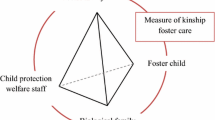Abstract
Children in the care and custody of the state are increasingly placed with “kin” rather than in “unrelated” foster homes. Current estimates suggest that 400,000 children are in kinship care arrangements, with a projected increase to over a half million by 1995 (Center for the Study of Social Policy, 1990). This article provides an overview of the trend toward increasing use of kinship care for foster children and the reasons for this development. It then presents the case management models currently used in kinship care cases by two large public child welfare agencies, and it concludes with discussion of these models and their implications.
Similar content being viewed by others
References
Adoption Assistance and Child Welfare Act 1980, P.L. 96-272.
American Public Welfare Association. (1990). Characteristics of children in substitute and adoptive care: A statistical summary of the VCIS national child welfare data base. Washington, DC: American Public Welfare Association.
Baltimore City Department of Social Services (DSS), Family & Children's Services. (1993). Unpublished quarterly program statistics. Baltimore: Author.
Berrick, J.D., Barth, R.P., & Needell, B. (in press, 1994). A comparison of kinship foster homes and foster family homes: Implications for kinship foster care as family preservation.Children and Youth Services Review.
Billingsley, A. (1992). Climbing Jacob's ladder: The enduring legacy of African-American families. New York: Simon & Schuster.
Center for the Study of Social Policy. (1990). The crisis in foster care. Washington, DC: The Family Impact Seminar (FIS).
Child Welfare League of America. (1992). Kinship care: A new look at an old idea.Children's Voice, 1 (3) (spring), 6–7, 22.
Children's Defense Fund. (1992). The state of America's children: 1992. Washington, D.C.: Author.
Dubowitz, H., Tepper, V., Feigelman, S., Sawyer, R., & Davidson, N. (1990). The physical and mental health and educational status of children placed with relatives—Final Report. Prepared for the Maryland Department of Human Resources and the Baltimore City Department of Social Services. Baltimore, MD.
Dubowitz, H., Feigelman, S., & Zuravin, S. (1993). A profile of kinship care.Child Welfare, 72, 2, 181–193.
Gabel, G. (1992). Preliminary report on kinship foster family profile. New York: Human Resources Administration, Child Welfare Administration.
Hegar, R.L. (1986). Siblings in foster care: A descriptive and attitudinal study. Unpublished dissertation, Tulane University School of Social Work.
Hegar, R.L. & Scannapieco, M. (in press). From family duty to family policy: The evolution of kinship care.Child Welfare.
Iglehart, A.P. (in press, 1994). Kinship foster care: Placement, service, and outcome issues.Children and Youth Services Review.
Illinois Department of Children and Family Services. (1990). Executive Summary. Chicago, IL: Illinois Department of Children and Family Services.
L.J. v. Massinga, 669 F. Supp. 508 (D. Md. 1989), affirmed, 838 F. 2d 118 (4th Cir.)
Maryland Department of Human Services. (1983). Circular letter #SSA 83-6.
National Commission on Family Foster Care. (1991). A blueprint for fostering infants, children and youth in the 1990s. Washington, DC: Child Welfare League of America.
Scannapieco, M. & Hegar, R.L. (1994). A comparison of kinship care and foster care in Baltimore County, Maryland (draft manuscript). Baltimore: University of Maryland School of Social Work.
Stack, C. (1974). All our kin: Strategies for survival in a black community. New York: Harper and Row.
Takas, M. (1993). Kinship care and family preservation: A guide for states in legal and policy development. Unpublished manuscript. Washington, D.C.: ABA Center on Children and the Law.
Task Fores on Permanency Planning for Foster Children, Inc. (1990). Kinship foster care: The double-edged dilemma. Rochester, NY: Task Force on Permanency Planning for Foster Children, Inc.
Thornton, J.L. (1991). Permanency planning for children in kinship foster homes.Child Welfare, 70 (5), 593–601.
United States House of Representatives, Select Committee on Children, Youth, and Families. (1990). No place to call home: Discarded children in America. Washington: U.S. Government Printing Office.
Author information
Authors and Affiliations
Rights and permissions
About this article
Cite this article
Scannapieco, M., Hegar, R.L. Kinship care: Two case management models. Child Adolesc Soc Work J 11, 315–324 (1994). https://doi.org/10.1007/BF01876557
Issue Date:
DOI: https://doi.org/10.1007/BF01876557




